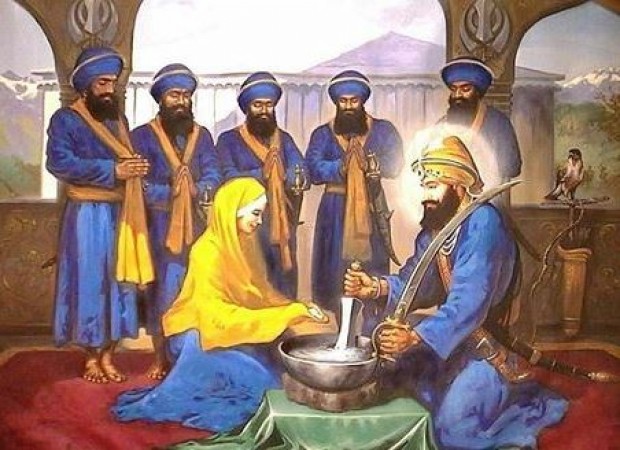
The poor Sikhs were plundered, and the priests and masands misappropriated the collected, according to several complaints made to the Guru. This decree was revoked by Guru Sahib, who also severely chastised the lawbreakers. In the future, during the annual Vaisakhi fair, the pious were to present their contributions straight to the Guru.
A strong, self-respecting community was something the Guru aimed to build. His bravery, heroism, and example of a hardworking, modest existence inspired the Sikhs. In order to produce the swords and lances his warriors would need, he established an arms factory in Anandpur. He once succumbed to the Brahmins' demand that he worship the goddess Durga to ensure victory and continued the farce until nothing changed. The Guru drew his sword from its sheath at the critical moment, proclaiming, "The sword is the Durga, which will give us victory over our enemies."
Also Read: Guru Gobind Singh Ji: Start Of Guruship
He advised Sikhs to travel directly to Anandpur without using any middlemen. Thus, the Guru developed a direct connection with his Sikh followers. The institution of the Khalsa took physical form on March 30, 1699, when a sizable gathering of Sikhs attended the Baisakhi festival at Anandpur.
Kesgarh Sahib in Anandpur held an outdoor diwan. The Guru grabbed his sword and demanded, "I want one head, is there anyone who can offer me?" in a booming voice.
The crowd was startled by this strange call and experienced some fear. There was total quiet. The Guru placed another call. Nobody approached us. Still more quiet could be heard. On the third call, a Khatri from Lahore named Daya Ram stood up and declared, "O true king, my head is at your service."
Also Read: Guru Gobind Singh Ji: New Prophet of All Humanity
Daya Ram was escorted into a tent by the Guru, who took him by the arm. There was a thud and a blow. When the Guru eventually emerged, his sword was covered in blood, and he cried out, "I want another head, is there anyone who can offer?" Dharam Das, a Jat from Delhi, called out again on the third call, saying, "O genuine king! My head is available for use.
I want another head; is there any dear Sikh who can donate it?, Dharam Das repeated as the Guru carried him inside the tent. A second blow and thud were then heard.
Some in the audience commented that the Guru had lost all sense of reason and went to his mother to complain after this.
Mohkam Chand, a calico printer/tailor of Dwarka (west coast of India) offered himself as a sacrifice. The Guru took him inside the tent and went through the same process. When he came out, he made a call for the fourth head. The Sikhs began to think that he was going to kill all of them.
Also Read: Guru Gobind Singh Ji : An Inspirational Person
While some of them fled, the others just hung their heads in disbelief. A fourth sacrifice was made by Jagan Nath Puri chef Himmat Chand. The Guru then issued his final and fifth request for a fifth head. A barber from Bidar (in central India) named Sahib Chand approached, and the Guru led him inside the tent. There was a thud and a blow.
He spent more time inside the tent than the previous time. People started to exhale in relief. They speculated that the Guru may have realized "his mistake" and stopped.
The Guru has now dressed his five volunteers in magnificent garb. They had given the Guru their heads in exchange for him giving them himself and his grandeur. They were in their most brilliant state when they were taken outside. Sighs of regret and wonderment could be heard coming from all directions. People were sorry they hadn't offered their heads earlier.
Also Read: Khanda Sahib: Khalsa Insignia
Since Guru Nanak's day, Charan Pauhal had been the accepted initiation ritual. The holy water that had been touched or cleaned by the Guru's toe or feet was to be consumed by the public. The Guru then ordered the five devoted Sikhs to rise up to introduce them into his new order (Khande di Pauhal).
He used a Khanda, a two-edged short sword, to stir pure water into an iron bowl (Batta of Sarbloh). He recited the Gurbani (Five Banis: Japji, Jaap Sahib, Anand Sahib, Swayas, and Chaupai) as he stirred the water with the Khanda. The water was blended with sugar crystals known as "Patasas," which, incidentally, Mata Sahib Kaur, the wife of the Guru, had brought just then.
Also Read: Significance Of Nishan Sahib
The Guru then rose to his feet while holding the prepared iron bowl of holy Amrit (nectar). Each of the five faithful gazed up to the Master while knelt on his left knee and waiting to be given the divine amrit. He sprinkled Amrit five times in each of their eyes and handed each person five palmfuls to drink, instructing them to recite out loud, "Waheguru Ji ka Khalsa, Waheguru Ji Ki Fateh," after each sprinkling. Then he sprinkled five times on the hair to anoint it (this signifies: Khalsa belongs to God and all victory be to His Name).
Also Read: Mata Gujri Ji: Great Sikh Woman
The five devoted were given Amrit in this manner from the same bowl. He then instructed them to drink Amrit from the same bowl to symbolize their entrance into the Khalsa, a casteless fraternity. The Guru baptized all five followers in this manner, addressing them as the "PANJ PYARE," or Five Beloved Ones, afterward.
Daya Ram became Daya Singh, Dharam Das became Dharam Singh, Mohkam Chand became Mohkam Singh, Himmat Chand became Himmat Singh, and Sahib Chand became Sahib Singh. He gave them the name SINGHS (Lions). The Guru then addressed them as THE KHALSA, referring to them as the ultimate, the freed, and the pure.
Also Read: Bhai Mani Singh Ji: Great Sikh Personality